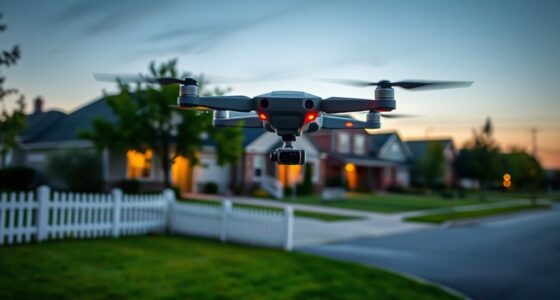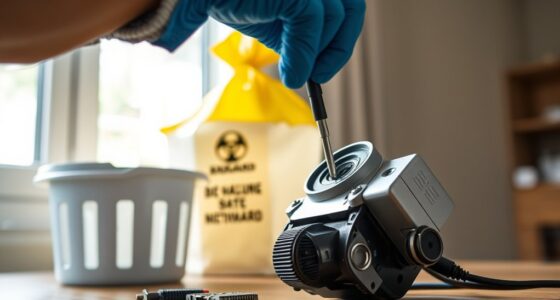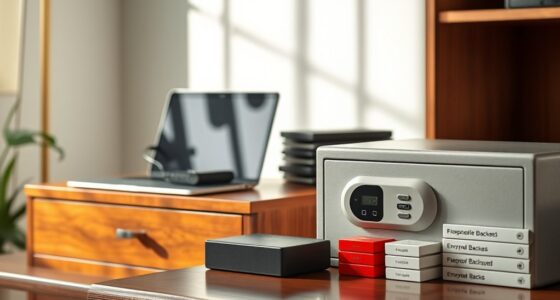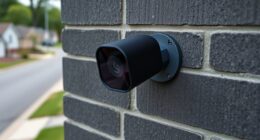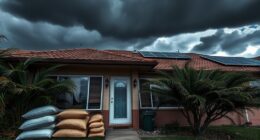To sweep your home for hidden cameras, start by inspecting common hiding spots like vents, picture frames, and electrical outlets. Use a flashlight to look for tiny lens reflections and employ RF detectors to identify wireless devices emitting signals. Conduct visual checks and systematic sweeps with your smartphone apps or laser pointers. Keep your space organized and secure. If you’re still unsure, you’ll discover more effective techniques and when to call professionals to guarantee your privacy.
Key Takeaways
- Use light reflection techniques and RF detectors to identify tiny camera lenses and wireless signals in common hiding spots.
- Regularly inspect areas like vents, picture frames, outlets, and electronic devices for suspicious reflections or unusual objects.
- Organize and clear clutter to create a clean environment, making hidden cameras easier to spot during sweeps.
- Employ tools like flashlights, mirrors, and scanning apps, and turn off lights to enhance detection of lens glints and reflections.
- When in doubt, seek professional counter-surveillance services to thoroughly detect advanced bugs and ensure privacy.
Recognizing Common Types of Hidden Cameras
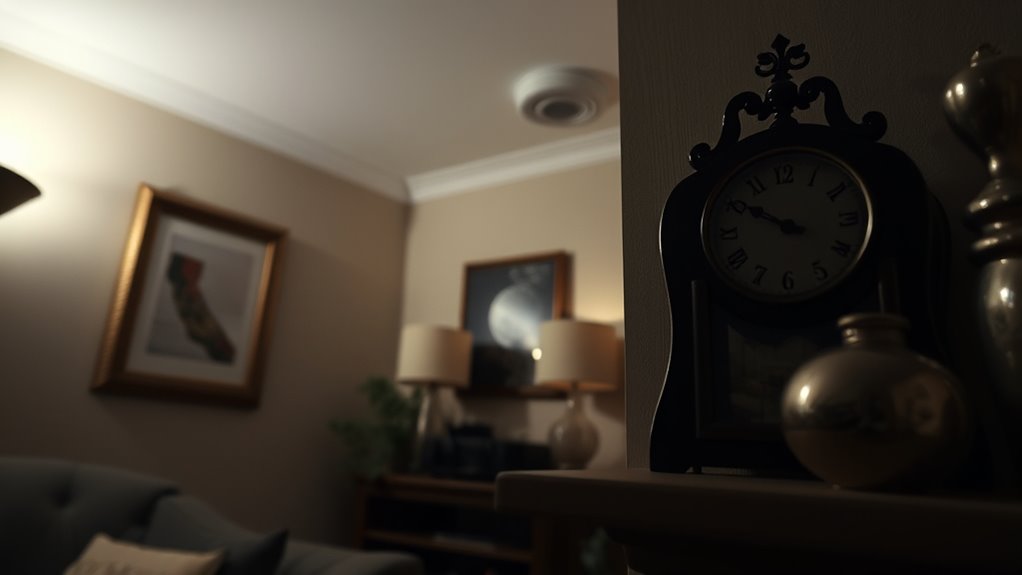
Hidden cameras come in many forms, making them easy to overlook if you’re not familiar with their common types. One key step is wireless camera identification, which involves scanning for signals that could indicate a hidden device. Use your phone or a specialized detector to check for unusual Wi-Fi networks or Bluetooth signals. Lens reflection techniques can also help you spot hidden cameras; hold a flashlight at different angles and look for tiny glints or reflections that reveal a camera lens. Pay attention to common hiding spots like smoke detectors, picture frames, or decorative objects. By understanding these methods, you can more effectively identify covert cameras and protect your privacy. Recognizing these typical types is essential before you proceed with a thorough sweep of your space. Additionally, understanding the color accuracy of your environment can help you notice anomalies in camera footage or reflections that might otherwise go unnoticed.
Preparing Your Space Before Sweeping
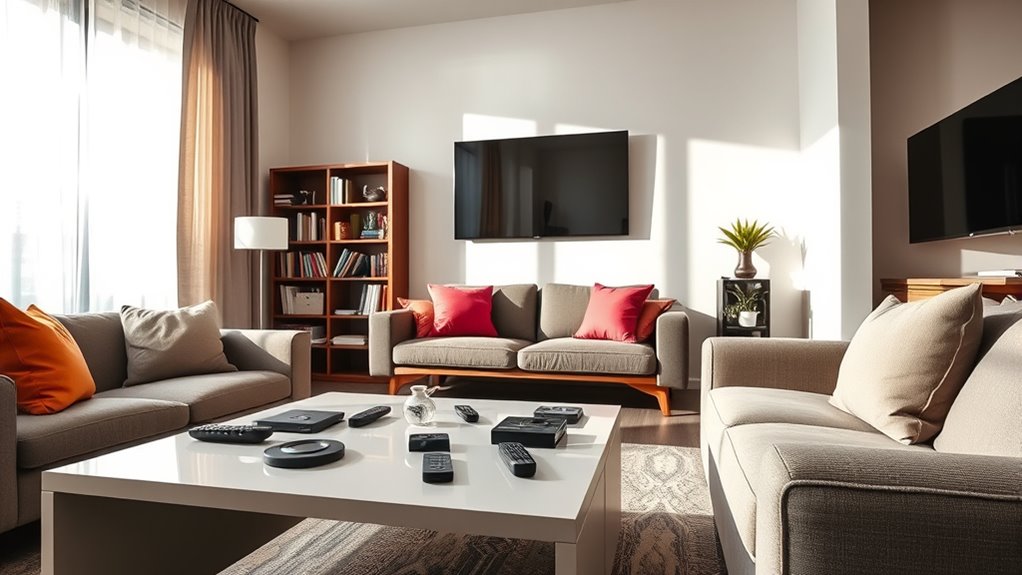
Before you start sweeping, clear your space of unnecessary clutter to guarantee missing hidden devices. Gather all the equipment you’ll need, like a flashlight, mirror, and RF detector, so you’re prepared. Taking these steps ensures a smoother, more effective sweep. Additionally, consider inspecting areas around water sources, such as sinks or bathtubs, where water-related devices could be concealed.
Clear Clutter Strategically
To guarantee your sweep is effective, start by clearing clutter strategically to create a clean and organized space. This clutter reduction not only simplifies inspection but also enhances the aesthetic appeal of your environment. Remove unnecessary items and organize surfaces to reduce hiding spots for cameras. A tidy space makes it easier to spot unusual objects or wires that could conceal a hidden camera. Consider this approach as an opportunity for aesthetic enhancement, making your home both safer and more pleasant. Here’s a quick guide:
| Clutter Reduction | Aesthetic Enhancement |
|---|---|
| Remove unnecessary items | Organize for visual appeal |
| Clear flat surfaces | Create a clean look |
| Minimize hiding spots | Improve overall ambiance |
Additionally, paying attention to your kitchen textiles and accessories can help you spot unusual items that might be hiding cameras.
Gather Necessary Equipment
Gathering the right equipment is essential to guarantee your sweep is thorough and effective. To address privacy concerns, make sure you have tools like a high-quality flashlight, a magnifying glass, and a camera detector or RF scanner. These devices help you identify hidden cameras or transmitting devices. Additionally, check your equipment regularly for proper maintenance; malfunctioning tools can lead to missed detections. Keep batteries charged and clean lenses for accurate readings. A smartphone with a camera and scanning apps can also be useful. Before you start, clear a workspace to organize your gear and prevent distractions. Properly maintained equipment boosts your confidence and ensures a comprehensive sweep, giving you peace of mind knowing your privacy is protected. Regularly updating your knowledge about counter-surveillance techniques can also enhance your effectiveness during the sweep.
Using Your Smartphone to Detect Hidden Devices
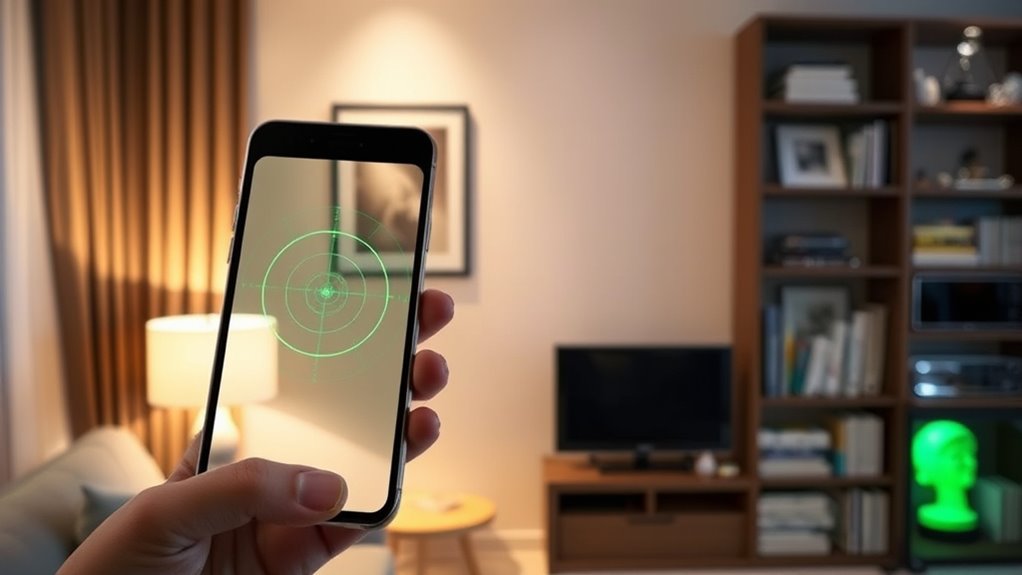
Your smartphone can be a valuable tool for detecting hidden surveillance devices, even if it wasn’t originally designed for that purpose. There are various smartphone apps available that can help you identify suspicious devices, often using features like infrared detection. Infrared detection works by revealing heat signatures emitted by electronic devices, making it easier to spot hidden cameras or listening devices that generate heat. Download reputable scanner apps that utilize your phone’s camera and sensors to scan your environment for unusual reflections or signals. Keep in mind that while these apps can be helpful, they’re not foolproof. Use them as part of a broader sweep, combining their insights with other techniques for better results. Your smartphone enhances your ability to quickly identify potential threats without specialized equipment.
Detecting Hidden Cameras With Flashlight Techniques
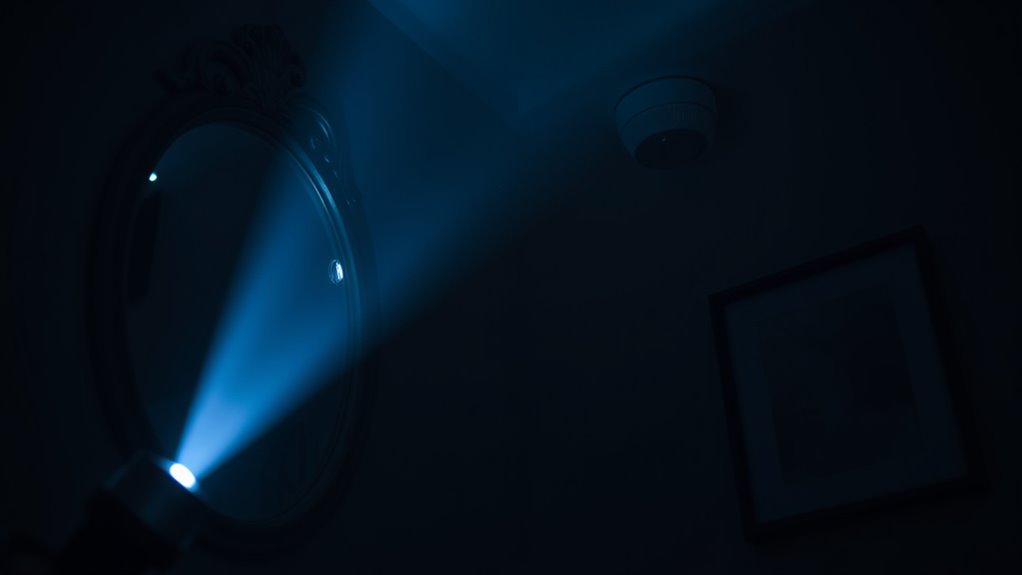
When searching for hidden cameras, turn off the lights and shine a flashlight slowly around the area. Look for reflections or glints from camera lenses that might catch the light unexpectedly. Spotting these tiny flashes can help you identify covert devices before they compromise your privacy. Additionally, being aware of data privacy concerns can help you understand the importance of safeguarding your personal space from invasive surveillance.
Using Light Reflections
Using light reflections is a practical way to spot hidden cameras that might be concealed in plain sight. Reflection techniques involve directing a flashlight or laser at suspect surfaces and observing for glints or unusual light bouncing back. To maximize effectiveness, carefully consider light source positioning—angle the light so it hits potential camera lenses or reflective surfaces directly. Move the light slowly across walls, mirrors, picture frames, and other objects where a hidden camera could be concealed. Look for tiny, bright flashes or irregular reflections that don’t match surrounding surfaces. Keep your movements deliberate and systematic, adjusting the light angle as needed. By paying attention to subtle reflections and employing proper light source positioning, you can improve your chances of detecting hidden cameras before they compromise your privacy. Additionally, understanding home decor styles can help you recognize unusual objects or placements that may hide surveillance devices.
Spotting Lens Glints
Spotting lens glints is a straightforward yet effective method for detecting hidden cameras with a flashlight. When you shine your light around a room, look for small, bright reflections called lens reflections or camera glints. These glints occur when the camera’s lens reflects the light directly back to you, creating tiny flashes of brightness. Move your flashlight slowly and systematically across surfaces, including vents, picture frames, and electronic devices. If you spot a sudden, consistent glint, it’s likely from a hidden camera lens. Remember, camera glints are usually brief and appear only when the lens is aligned with your light source. By paying close attention to these reflections, you can quickly identify suspicious spots and locate concealed cameras. Recognizing recurring patterns or number sequences associated with these reflections can sometimes provide additional clues about hidden surveillance devices.
Employing RF Detectors to Find Wireless Cameras
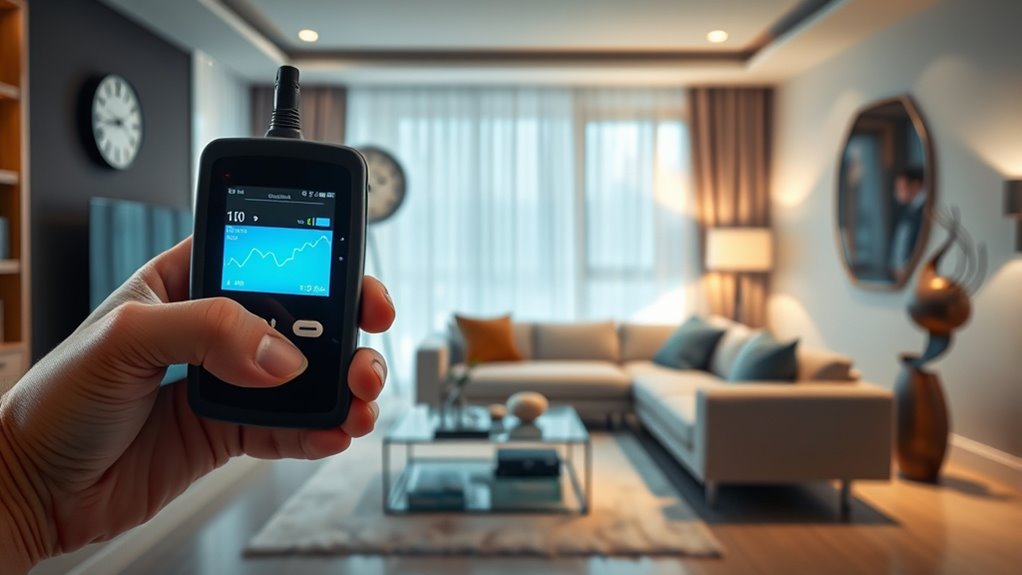
Employing RF detectors is an effective way to locate wireless cameras that transmit signals within a specific frequency range. By using rf signal scanning, you can identify active wireless devices hidden in your environment. These detectors analyze the radio frequency spectrum to detect unusual or suspicious signals that may originate from hidden cameras. When you conduct device frequency analysis, you look for consistent signals that don’t match normal household devices. Move the RF detector slowly around the room, paying attention to areas where signals are strongest. If you find a signal, note its strength and frequency. This process helps you pinpoint potential camera locations without relying solely on visual clues, making RF detectors a critical tool in your counter-surveillance efforts. Additionally, understanding the spectrum of wireless signals can help you better interpret the data collected during your scan.
Conducting a Visual Inspection of Your Environment
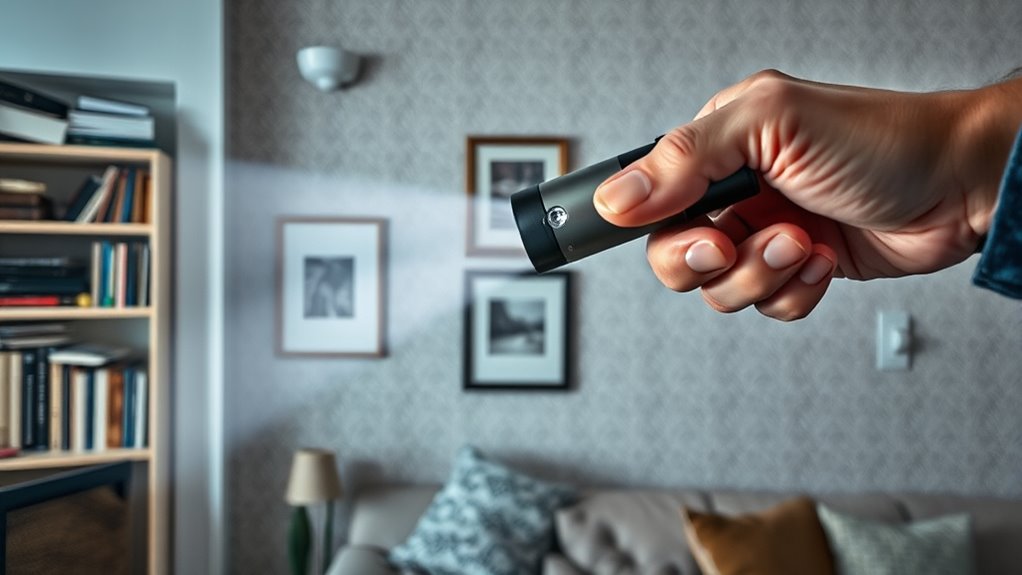
Have you thoroughly examined your environment for hidden cameras? Conducting a visual inspection helps you spot suspicious devices or unusual objects that might compromise your privacy. Look closely at common hiding spots, such as smoke detectors, picture frames, electrical outlets, and decorative items. Keep an eye out for tiny lenses or unusual wires. Use a flashlight to scan dark areas, as lenses may reflect the light. Be aware of legal considerations—altering or removing devices without permission could be problematic. Trust your instincts when something seems out of place. This simple yet effective step allows you to identify potential surveillance threats and address privacy concerns proactively. Regular inspections help maintain your privacy and ensure you’re aware of any hidden cameras in your environment. Additionally, detecting small electronic devices can be facilitated by using a radio frequency (RF) scanner, which can pick up wireless signals emitted by covert cameras.
Tips for Securing Your Home Against Surveillance Devices
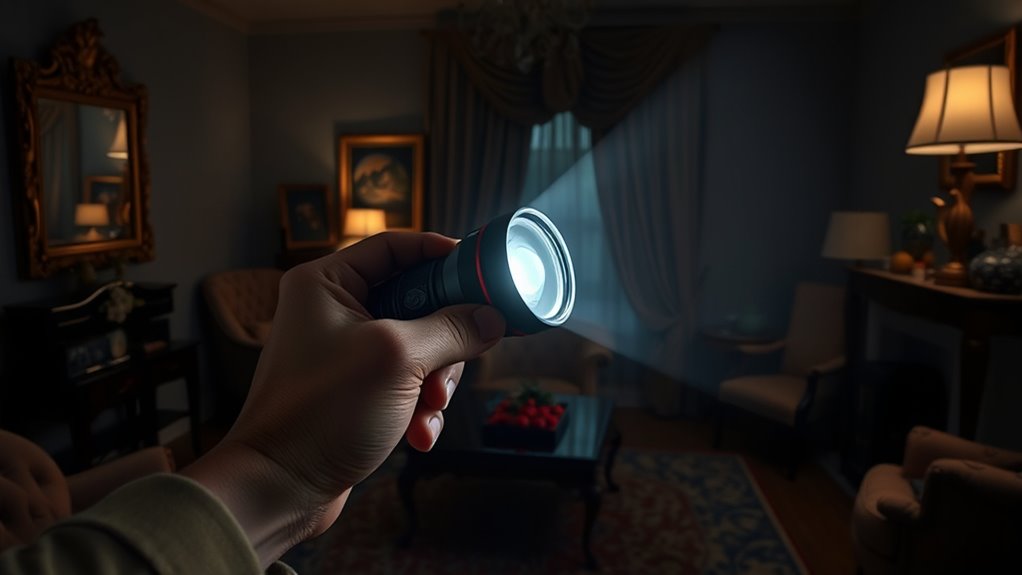
Once you’ve identified potential surveillance devices through visual inspection, the next step is to implement practical measures that protect your home from unauthorized monitoring. To address privacy concerns and legal considerations, consider regularly checking for hidden cameras and securing entry points. Use physical barriers like locked cabinets or signal jammers where appropriate, but always stay within legal boundaries. Be aware of local laws regarding surveillance devices to avoid legal pitfalls. Implementing routine sweeps and maintaining control over your environment reduces the risk of covert surveillance. Here’s a quick guide to help you stay protected:
| Action | Privacy Concern | Legal Consideration |
|---|---|---|
| Regular inspections | Unauthorized recording of personal info | Compliance with privacy laws |
| Secure entry points | Unauthorized access to devices | Avoiding illegal surveillance |
| Use signal jammers | Disrupting surveillance signals | Legal restrictions on jamming |
| Document findings | Evidence for legal action | Protecting your rights |
Additionally, staying informed about surveillance device regulations can help you avoid inadvertent legal violations and ensure your privacy measures are effective.
When to Seek Professional Help
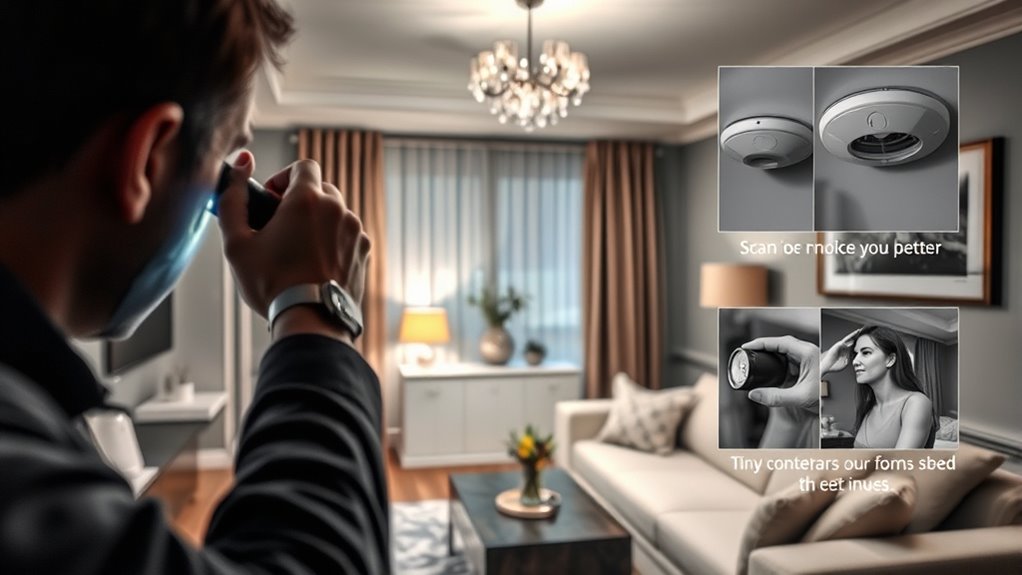
Knowing when to seek professional help is essential if your efforts to detect and block surveillance devices haven’t yielded clear results or if you suspect persistent or sophisticated monitoring. If you notice signs like unexplained electronic interference, strange device placements, or ongoing privacy concerns, it’s time to call in experts. Imagine: a technician carefully inspecting hidden spots, scanning for advanced bugs, and evaluating your home’s electrical systems. Consider these scenarios:
- You find a tiny, unfamiliar camera lens in a discreet spot.
- Electronic devices behave erratically without explanation.
- You experience ongoing privacy breaches despite sweeping efforts.
- Legal considerations make professional detection necessary to avoid unintentional violations.
Professional help ensures thorough detection, respects privacy laws, and provides peace of mind against hidden threats.
Frequently Asked Questions
How Often Should I Perform a Home Sweep for Hidden Cameras?
You should perform a home sweep for hidden cameras at least once every three to six months, depending on your privacy frequency and recent activities. Regular detection frequency helps you stay aware of potential threats. If you notice anything suspicious or have recently had visitors or deliveries, increase your sweeps. Staying vigilant and consistent guarantees your privacy remains protected and helps you catch any hidden devices early.
Are There Legal Restrictions on Using RF Detectors in Private Homes?
You should check local laws before using RF detectors in your private home. Legal restrictions and RF detector laws vary by jurisdiction, so it’s essential to research specific regulations in your area. Generally, using RF detectors isn’t illegal if you own the device and use it for personal security. However, avoid invasive searches or actions that could breach privacy laws, and always stay informed about any restrictions on electronic surveillance tools.
Can Hidden Cameras Be Detected Through Walls or Ceilings?
Ever wonder if hidden cameras can hide behind walls or ceilings? They generally can’t be detected through solid structures, but you can use wireless signal detection and infrared camera scanning to find cameras transmitting signals inside your home. These methods help locate devices that emit radio frequencies or infrared light, but they won’t see through walls or ceilings directly. Stay vigilant and combine techniques for the best protection.
What Are Signs That a Device Is Actively Recording?
You can spot if a device is actively recording by checking for device indicators like blinking lights or sound alerts. Recording indicators, such as LED lights or flashing signals, often demonstrate that the device is capturing footage. Pay attention to unusual or unexpected lights on electronics or hidden objects, and listen for clicking sounds or beeps, which may also signal active recording. Staying alert helps ensure your privacy stays protected.
How Can I Prevent Future Hidden Camera Installations?
To prevent future hidden camera installations, you should secure your space with strong locks, install trusted security cameras, and regularly audit your environment. Limit access to sensitive areas, update your privacy policy tips, and be cautious of unknown devices. You can also educate yourself on security camera installation practices, stay vigilant for suspicious objects, and consider professional counter-surveillance services. These steps help protect your privacy and deter covert monitoring.
Conclusion
By staying vigilant and knowing what to look for, you become the guardian of your own privacy, steering through the shadows like a detective in the night. With each sweep and scan, you weave a shield of security around your sanctuary, turning hidden eyes into blind spots. Remember, your awareness is the lighthouse guiding you through the fog of surveillance, ensuring your home remains a safe harbor where your privacy can flourish undisturbed.

